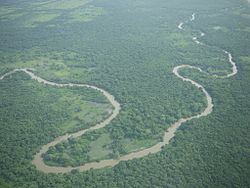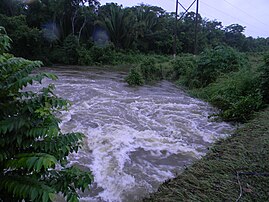Belize River
| Belize River | |
|---|---|
 Aerial view of the Belize River | |
| Location | |
| Country | Belize |
| Physical characteristics | |
| Source | |
| • location | Confluence Mopan and Macal rivers |
| • coordinates | 17°10′42″N 89°04′49″W / 17.17841°N 89.08016°W |
| • elevation | 80 m (260 ft) |
| Mouth | |
• location | Caribbean Sea at Belize City |
• coordinates | 17°32′04″N 88°14′12″W / 17.53456°N 88.23664°W |
• elevation | 0 m (0 ft) |
| Length | 290 km (180 mi) (including Mopan River) |
| Basin size | Caribbean Sea |
The Belize River runs 290 kilometres (180 mi)
Also known as the Old River, the Belize River begins where the Mopan River and Macal River join just east of San Ignacio, Belize (17°11′N 89°04′W / 17.183°N 89.067°W). The Belize River – Mopan River Catchment contains over 45 percent of the population of Belize. The Belize River, in spite of 78 runs or rapids, is passable via the Mopan to the Guatemalan border. It served as the main artery of commerce and communication between the interior and the coast until well into the twentieth century, and has long been associated with forestry, of logwood (for dye) and of mahogany which survives in small stands.[2]: 111
Early on, loggers using the river encountered the
Today the Belize River is a vital source of drinking water and other domestic use for the populations living along the river; however, water quality is degraded from sediment, nutrient loading, pesticides and other toxins. The major source of degradation is the extensive deforestation in the upper reaches of the Mopan River and non-sustainable agriculture. Karper and Boles have asserted: "The greater Mopan/Belize River Catchment provides a prime example of a watershed under stress from extensive non-sustainable agricultural practices that have occurred within the region over the past three decades."[5] Traditional slash and burn agricultural practices also contribute to watershed degradation.
Maya sites
There are a number of Maya archaeological sites in the watershed of the Belize River and its tributaries: Mopan River, Macal River, and Chaa Creek. These sites include Xunantunich, Chaa Creek,[6] and Cahal Pech.[7]
Gallery
References
- ^ Belize River at the Encyclopædia Britannica. Retrieved 11 June 2015.
- ^ a b Woods, Charles M. Sr.; et al. (2015). Years of Grace: The History of Roman Catholic Evangelization in Belize: 1524-2014. Belize City: Roman Catholic Diocese of Belize City-Belmopan.
- ^ Bolland, O.N. (1988). Colonialism and resistance in Belize: Essays in historical sociology. Belize: Cubola. p. 93.
- ^ Metzgen, M.S. & Cain, H.E.C. (1925). The Handbook of British Honduras. London: The West India Committee. pp. 45f.
- ^ Jes Karper and Ed Boles, Human Impact Mapping of the Mopan and Chiquibul Rivers within Guatemala and Belize (2003). Retrieved June 20, 2015.
- ^ C.Michael Hogan, Chaa Creek, Megalithic Portal, ed. A. Burnham, 2007. Retrieved June 20, 2015.
- ^ Distribution of Early Middle Formative Period Sites Archived 2003-02-20 at the Wayback Machine. Retrieved June 20, 2015.





